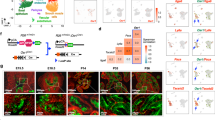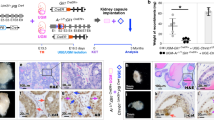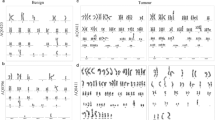Abstract
Interactions between polypeptide growth factors and the androgen receptor (AR) are important for regulation of cellular events in carcinoma of the prostate. Basic fibroblast growth factor (bFGF), the prototype of heparin-binding growth factors, and the AR are commonly expressed in prostate cancer. bFGF diminished prostate-specific antigen protein in the supernatants of androgen-stimulated human prostate cancer cells LNCaP by 80%. In the present study, we asked whether the bFGF effect on prostate-specific antigen is preceded by action on AR expression. LNCaP cells were treated with bFGF and AR protein expression was determined by immunoblotting and ligand binding assay. bFGF down-regulated AR protein in a dose-dependent manner showing a maximal effect at 50 ng ml−1both in the presence or absence of dihydrotestosterone. Down-regulation of AR protein expression occurred already after 8 h of bFGF treatment and a maximal inhibition was observed 24 h after addition of bFGF to culture media. As AR expression can be reduced by an increase in intracellular calcium levels, we investigated whether the bFGF effect on AR protein is mediated by this mechanism. Calcium release from intracellular stores and store-operated calcium influx after treatment with either bFGF or calcium ionophore A 23187 were measured by single cell fluorescence technique. The ionophore A 23187 was able to induce calcium influx and an increase in cytoplasmic calcium concentration in LNCaP cells. In contrast, bFGF was incapable of eliciting a similar effect. In contrast to AR protein, AR mRNA levels were not affected by bFGF as shown by semiquantitative reverse transcription polymerase chain reaction. In summary, these studies show that bFGF is a potent negative regulator of AR protein expression in the human prostate cancer cell line LNCaP. © 2000 Cancer Research Campaign
Similar content being viewed by others
Article PDF
Change history
16 November 2011
This paper was modified 12 months after initial publication to switch to Creative Commons licence terms, as noted at publication
References
Baird A and Böhlen P (1991) Fibroblast growth factors. Peptide Growth Factors and Their Receptors I, Sporn MB, Roberts AB (eds), pp 369–418. Springer: Heidelberg
Bikfalvi A (1995) Significance of angiogenesis in tumour progression and metastasis. Eur J Cancer 31A: 1101–1104
Bradford M (1978) A rapid and sensitive method for the quantitation of microgram quantities of protein using the principle of protein-dye binding. Anal Biochem 72: 248–254
Chaproniere DM and McKeehan WL (1986) Serial culture of single adult human prostatic epithelial cells in serum-free medium containing low calcium and a new growth factor from bovine brain. Cancer Res 46: 819–824
Cheng B, McMahon DG and Mattson MP (1993) Modulation of calcium current, intracellular calcium levels and cell survival by glucose deprivation and growth factors in hippocampal neurons. Brain Res 607: 275–285
Cronauer MV, Hittmair A, Eder IE, Hobisch A, Culig Z, Ramoner R, Zhang J, Bartsch G, Reissigl A, Radmayr C, Thurnher M and Klocker H (1997a) Basic fibroblast growth factor levels in cancer cells and in sera of patients suffering from proliferative disorders of the prostate. Prostate 31: 223–233
Cronauer MV, Eder IE, Hittmair A, Sierek G, Hobisch A, Culig Z, Thurnher M, Bartsch G and Klocker H (1997b) A reliable system for the culture of human prostatic cells. In Vitro Cell Dev Biol Anim 33: 742–744
Culig Z, Hobisch A, Herold M, Hittmair A, Thurnher M, Eder IE, Cronauer MV, Rieser C, Ramoner R, Bartsch G, Klocker H and Konwalinka G (1998) Interleukin-1β mediates the modulatory effects of monocytes on LNCaP human prostate cancer cells. Br J Cancer 78: 1004–1011
Eder IE, Stenzl A, Hobisch A, Cronauer MV, Bartsch G and Klocker H (1997) Expression of transforming growth factors beta-1, beta 2 and beta 3 in human bladder carcinomas. Br J Cancer 75: 1753–1760
Froesch BA, Takayama S and Reed JC (1998) BAG-1L protein enhances androgen receptor function. J Biol Chem 273: 11660–11666
Gleave ME, Hsieh JT, Wu HC, von Eschenbach AC and Chung LWK (1992) Serum prostate specific antigen levels in mice bearing human prostate LNCaP tumors are determined by tumor volume and endocrine and growth factors. Cancer Res 52: 1598–1605
Gong Y, Blok LJ, Perry JE, Lindzey JK and Tindall DJ (1995) Calcium regulation of androgen receptor expression in the human prostate cancer cell line LNCaP. Endocrinology 136: 2172–2178
Grant ES, Batchelor KW and Habib FK (1996) Androgen independence of primary epithelial cultures of the prostate is associated with a down-regulation of androgen receptor gene expression. Prostate 29: 339–349
Grynkiewicz G, Poenie M and Tsien RY (1985) A new generation of Ca2+indicators with greatly improved fluorescence properties. J Biol Chem 260: 3440–3450
Henttu P and Vihko P (1993) Growth factor regulation of gene expression in the human prostatic carcinoma cell line LNCaP. Cancer Res 53: 1051–1058
Hobisch A, Culig Z, Radmayr C, Bartsch G, Klocker H and Hittmair A (1995) Distant metastases from prostatic carcinoma express androgen receptor protein. Cancer Res 55: 3068–3072
Hobisch A, Culig Z, Radmayr C, Bartsch G, Klocker H and Hittmair A (1996) Androgen receptor status of lymph node metastases from prostate cancer. Prostate 28: 129–135
Hrzenjak M and Shain SA (1997) Fibroblast growth factor-2 and TPA enhance prostate cancer cell proliferation and activate members of the ras and PKC signal transduction pathways. Recept Signal Tranduct 7: 207–219
Hurley MM, Marcello K, Abreu C and Kessler M (1996) Signal transduction by basic fibroblast growth factor in rat osteoblastic Py1a cells. J Bone Mineral Res 11: 1256–1263
Ikonen T, Palvimo JJ, Kallio PJ, Reinikainen P and Jänne OA (1994) Stimulation of androgen-regulated transactivation by modulators of protein phosphorylation. Endocrinology 135: 1359–1366
Kallio PJ, Jänne OA and Palvimo JJ (1994) Agonists, but not antagonists, alter the conformation of the hormone-binding domain of androgen receptor. Endocrinology 134: 998–1001
Krongrad A, Wilson CM, Wilson JD, Allman DR and McPhaul MJ (1991) Androgen increases androgen receptor protein while decreasing receptor mRNA in LNCaP cells. Mol Cell Endocrinol 76: 79–88
Merle PL, Usson Y, Robert-Nicoud M and Verdetti J (1997) Basic FGF enhances calcium permeable channel openings in adult rat cardiac myocytes: implication in the bFGF-induced increase of free Ca2+content. J Mol Cell Cardiol 29: 2687–2698
Meyer GE, Yu E, Siegal JA, Petteway JC, Blumenstein BA and Brawer MK (1995) Serum basic fibroblast growth factor in men with and without prostate carcinoma. Cancer 76: 2304–2311
Milasincic DJ, Calera MR, Farmer SR and Pilch PF (1996) Stimulation of C2C12 myoblast growth by basic fibroblast growth factor and insulin-like growth factor 1 occur via mitogen-activated protein kinase-dependent and -independent pathways. Mol Cell Biol 16: 5964–5973
Mizokami A, Saiga H, Matsui T, Mita T and Sugita A (1992) Regulation of androgen receptor by androgen and epidermal growth factor in a human prostatic cancer cell line, LNCaP. Endocrinol Jpn 39: 235–243
Mizokami A, Yeh SY and Chang C (1994) Identification of 3′5′-cyclic adenosine monophosphate response element and other cis-acting elements in the human androgen receptor gene promoter. Mol Endocrinol 8: 77–88
Nakamoto T, Chang CS, Li AK and Chodak GW (1992) Basic fibroblast growth factor in human prostate cancer cells. Cancer Res 52: 571–577
Peehl DM and Stamey TA (1986) Serum-free growth of adult human prostatic epithelial cells. In Vitro Cell Dev Biol 22: 82–90
Peterziel H, Culig Z, Stober J, Hobisch A, Radmayr C, Bartsch G, Klocker H and Cato AC (1995) Mutant androgen receptors in prostatic tumors distinguish between amino-acid-sequence requirements for transactivation and ligand binding. Int J Cancer 63: 544–550
Raffioni S and Bradshaw RA (1992) Activation of phosphatidylinositol 3-kinase by epidermal growth factor, basic fibroblast growth factor, and nerve growth factor in PC12 pheocromocytoma cells. Proc Natl Acad Sci USA 89: 9121–9125
Russell PJ, Bennett S, Joshua A, Yu Y, Downing SR, Hill MA, Kingsley EA, Mason RS and Berry J (1999) Elevated expression of FGF-2 does not cause prostate cancer progression in LNCaP cells. Prostate 40: 1–13
Sa G and Fox PL (1994) Basic fibroblast growth factor-stimulated endothelial cell movement is mediated by a pertussis toxin-sensitive pathway regulating phospholipase A2 activity. J Biol Chem 269: 3219–3225
Shain SA, Saric T, Ke LD, Nannen D and Yoas S (1996) Endogenous fibroblast growth factor-1 or fibroblast growth factor-2 modulate prostate cancer cell proliferation. Cell Growth Diff 7: 573–586
Sherwood E, Lee C and Kozlowski JM (1992) Basic fibroblast growth factor: a potential mediator of stromal growth in the human prostate. Endocrinology 130: 2955–2963
Story MT, Livingston B, Baeten L, Schwartz SJ, Jacobs SC, Begun FP and Lawson RK (1989) Cultured human prostate-derived fibroblasts produce a factor that stimulates their growth with properties indistinguishable from basic fibroblast growth factor. Prostate 15: 355–365
Suzuki A, Shinoda J, Kanda S, Oiso Y and Kozawa O (1996) Basic fibroblast growth factor stimulates phosphatidylcholine-hydrolyzing phospholipase D in osteoblast-like cells. J Cell Biochem 63: 491–499
Tilley WD, Wilson CM, Marcelli M and McPhaul MJ (1990) Androgen receptor gene expression in human prostate carcinoma cell lines. Cancer Res 50: 5382–5386
Tinhofer I, Maly K, Dietl P, Hochholdinger F, Mayr S, Obermeier A and Grunicke HH (1996) Differential Ca2+signaling induced by activation of the epidermal growth factor and nerve growth factor receptors. J Biol Chem 271: 30505–30509
Van der Kwast TH, Schalken J, Ruizeveld de Winter JA, van Vroonhoven CCJ, Mulder E, Boersma W and Trapman J (1991) Androgen receptors in endocrine-therapy-resistant human prostate cancer. Int J Cancer 48: 189–193
Veldscholte J, Ris-Stalpers C, Kuiper GGJM, Jenster G, Berrevoets C, Claassen E, van Rooij HCJ, Trapman J and Brinkmann AO (1990) A mutation in the ligand binding domain of the androgen receptor of human LNCaP cells affects steroid binding characteristics and response to anti-androgens. Biochem Biophys Res Commun 17: 534–540
Wasilenko WJ, Cooper J, Palad AJ, Somers KD, Blackmore PF, Rhim JS, Wright GLJ and Schellhammer PF (1997) Calcium signaling in prostate cancer cells: evidence for multiple receptors and enhanced sensitivity to bombesin/GRP. Prostate 30: 167–173
Wiren KM, Zhang X, Chang C, Keenan E and Orwoll ES (1997) Transcriptional up-regulation of the human androgen receptor by androgen in bone cells. Endocrinology 138: 2291–2300
Yeh S and Chang C (1996) Cloning and characterization of a specific coactivator, ARA70, for the androgen receptor in human prostate cells. Proc Natl Acad Sci USA 93: 5517–5521
Young C-F, Murtha PE, Andrews PE, Lindzey JK and Tindall DJ (1994) Antagonism of androgen action in prostate tumor cells by retinoic acid. Prostate 25: 39–45
Zhou ZX, Lane MV, Kemppainen JA, French FS and Wilson EM (1995) Specificity of ligand-dependent androgen receptor stabilization: receptor domain interactions influence ligand dissociation and receptor stability. Mol Endocrinol 9: 208–218
Author information
Authors and Affiliations
Rights and permissions
From twelve months after its original publication, this work is licensed under the Creative Commons Attribution-NonCommercial-Share Alike 3.0 Unported License. To view a copy of this license, visit http://creativecommons.org/licenses/by-nc-sa/3.0/
About this article
Cite this article
Cronauer, M., Nessler-Menardi, C., Klocker, H. et al. Androgen receptor protein is down-regulated by basic fibroblast growth factor in prostate cancer cells. Br J Cancer 82, 39–45 (2000). https://doi.org/10.1054/bjoc.1999.0874
Received:
Revised:
Accepted:
Published:
Issue date:
DOI: https://doi.org/10.1054/bjoc.1999.0874
Keywords
This article is cited by
-
The evolutionary impact of androgen levels on prostate cancer in a multi-scale mathematical model
Biology Direct (2010)
-
Nitric oxide-mediated inhibition of androgen receptor activity: possible implications for prostate cancer progression
Oncogene (2007)
-
Inhibition of p53 function diminishes androgen receptor-mediated signaling in prostate cancer cell lines
Oncogene (2004)



